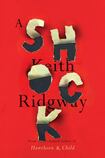
There is a special kind of reading pleasure in books that feature seemingly disconnected stories of interlocking lives. The American author Elizabeth Strout is a master of the style – her Lucy Barton and Olive Kitteridge books provide layered, detailed pictures of ordinary lives, the “little bursts” of joy or sadness that her characters in rural Maine encounter on any given day.
Here at home in recent years, the format worked brilliantly for Donal Ryan in his Booker-nominated The Spinning Heart, and similarly so for Keith Ridgway in Hawthorn & Child, though the latter did not garner as much attention.
Ridgway has returned to interlinked stories for his clever and provocative seventh novel, which has interesting things to say about loss and survival. As with Hawthorn & Child, the titled sections work as stories in their own right, though with a gnawing sense that something more is happening beneath the surface. Readers are instantly involved in the action of Ridgway’s worlds, the characters he writes with great compassion and clarity, and always with an awareness of the fuzziness of being alive, the answers and enlightenments that come too late, or not at all.
A Shock is a more postmodern affair than his previous books. There are fragmented scenes, pages of protracted dialogue in a hyper-realist mode, descriptive passages that read like stage directions, and an authorial voice that intrudes on action to deliberately take the reader out of the story: “Yves is the same man that Stan calls Stoker and Gary calls Yan, or Yanko. Anna is the woman Maria thinks of as Mrs Grant. She is Anna Grant.”
The author draws attention to the artifice of storytelling from the opening scene, in which a gay couple call to their older female neighbour with a bottle of wine, earplugs and an iPod in a veiled (and hilariously passive-aggressive) attempt to mitigate against noise from their upcoming party. Ridgway’s skill here and throughout is in showing the situation from both perspectives at once – the eagerness and excitement of the party-throwers versus the ageing woman who lives alone after the recent death of her husband.
To give too much away about the characters and scenarios detracts from the art of the book. The delights are in the surprises and shocks, the connections that may or may not be there. Standout pieces include a drug-fuelled session with two gay men on a scorching Saturday, a multifaceted conversation in a cafe, and the story of a young couple, Stan and Maria, with a rat problem in their flat.
Ridgway was born in Dublin and now lives in London. His adopted home certainly comes to life here; the grime and gratifications of city living are writ large among the stories of his characters. “Stepping outside the door in London costs money,” says one young man. Elsewhere, a cyclist notes that “drivers saw the helmet and recalculated the risk”. There is a deceptive simplicity to the observations (“she was exhausted by the job of listening”) and yet their meaning and accuracy linger in a way that many more fancily phrased insights do not.
A book like this hinges on the power of the connections, and Ridgway puts his
own stamp on the genre by surprising the reader. There are crumbs that don't lead anywhere. There are forests with no way out. Our synapses are firing at all times, trying to make sense of where we are, who knows whom, what may happen to certain characters once they leave the stage. Throughout, Ridgway asks the reader to question the very human impulse to put shape on something as shape-shifting as life.
The opposite of life is also ever-present in these stories. “He was dead,” says a character of her husband’s sudden passing. “I would rather a shock than a terror.” In a book that handles multiple timeframes with remarkable ease, we are told: “There is only now, in all its perpetual detail, as deep as a well.” Other characters vanish into walls or hide in the eaves of houses.
Imagery connects the narratives. There is plenty of vermin, and plenty of holes – in buildings, in the body, in the mind. The depictions are visceral and graphic, at times biblical and grotesque.For a novel that is essentially anti-resolution, the ending is particularly effective, bringing closure but also a sense of beginning again.
The great trick of Ridgway’s writing is that it frequently manages to do two conflicting things at once: “And what was wrong with it anyway? Making things up and saying them and making a world out of that. What was wrong with it?”











